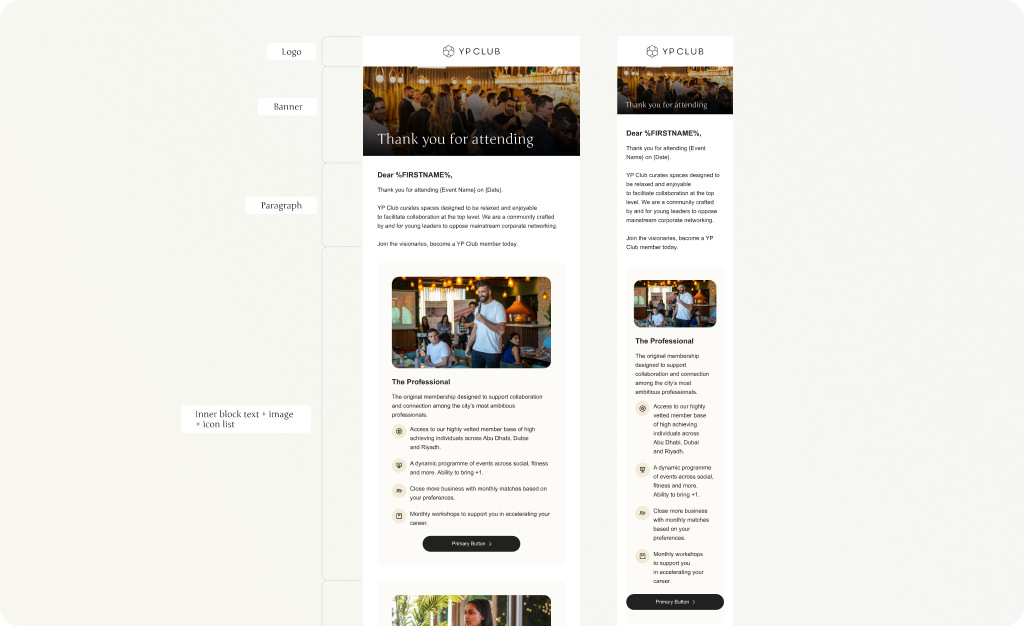
Saving on email design without sacrificing quality: how to use email master templates in SMB
Every other SMB client I speak with asks me this: “Vasily, are you sure that you need to involve a designer for each email? Aren’t you overcomplicating the process? Maybe you can just build one master template, and we will fill it with content?”
Let’s first take a step back: what is a “master template”?
| A master template is a set of standard components – modules – from which an email newsletter is created. The layout and design are pre-built for each module, so emails can be assembled like a Lego toy, changing only the illustrations and text. |
The logic behind this question is clear. Email designs will look largely similar in any case, as they follow the same brand guide. So it’s only natural to want to save on design costs and not to design the same thing multiple times. The thinking goes, it isn’t hard to put one module on top of the other, we can do this ourselves without involving a designer.
My answer to the question “ is it possible to build quality emails without involving a designer when using a master template?” is a qualified “Yes”.
There are several things to pay attention to.
Initially, the idea of using master templates originated in large companies, where brand uniformity rather than economy was chief concern. Such companies have several departments that design emails, and even when using a common brand book, the look may not be uniform . The master template solved this problem.
Risks when using master templates
What can go wrong?
- Having a master template does not guarantee quality. People still make mistakes – an email may still have a wrong concept, stale copy , typos and poorly designed banners.
- No reduction of effort. Some businesses are surprised to discover that when they use a master template they actually have to put more hours into each email than a copywriter and a designer combined did without one. Especially when quality demands are not reduced.
- The master template is there, but the emails are not. Some companies just forget that building emails takes time, and someone’s time still needs to be allocated, even with a new tool.
Why is this happening?
The idea of saving money with a master template may be so appealing that companies forget about planning. Even with a master template, you need to define responsibilities, verify the skills, and monitor the results.
How to avoid running into these obstacles?
- Determine the type of templates you need. Master templates differ in their technical implementation: they can be built in ESP block editors, in HTML or in Figma. Each option presents different requirements for the marketer’s skills.
- Analyze your resources and make a plan. Look at what external and internal specialists you have, what skills they have. Distribute responsibilities between them – who will be responsible for the content, design, layout and testing of each newsletter.
- Set expectations for design complexity based on the type of newsletter. Some types of emails, such as transactional emails or news digests, are fine with a simple design because the readers do not expect more from them. Such emails are where most effort will be saved with a master template..
And bear in mind that sometimes you will need variety even with a master template. Some occasions call for a breakout design that is not similar to your typical email. You won’t send New Year’s greetings using the same template as a password change confirmation, would you?
Take a look at our design down below.

 Can you have an in-house email marketer AND an agency?
Can you have an in-house email marketer AND an agency?
Can a company work with an agency while also having an in-house email marketer? Has your company ever considered hiring an email marketing agency? — Why? — an in-house email specialist might say, perceiving this question as a threat to their job. — We already have someone handling email marketing, and that someone is me! […]
 Saving on email design without sacrificing quality: how to use email master templates in SMB
Saving on email design without sacrificing quality: how to use email master templates in SMB
A master template is a set of standard components – modules – from which an email newsletter is created. The layout and design are pre-built for each module, so emails can be assembled like a Lego toy, changing only the illustrations and text.
 Review the concept of your next email
Review the concept of your next email
In our agency, email campaigns pass through QA at every stage of production. We use the “four eyes” principle to check the email’s quality at specification, design, coding and platform stages.